Abstract
The article addresses the methodology and the results of studies of vibroacoustic phenomena generated by tram vehicles. While a tram was running at various speeds, both the noise level and surface vibrations were recorded simultaneously. These quantities determine the overall impact of tram cars on their environment. The research assumptions made enable assessment of accretion of these effects in the function of running speed, which may prove particularly for the sake recommendations as to the permissible speed of trams in urban conditions.
1. Introduction
Studies of vibroacoustic phenomena play an increasingly important role in the field of engineering research. Their popularity results from a number of advantages, among which one should particularly stress their non-invasive nature, large information capacity of vibration and acoustic signals as well as the considerable range and availability of measuring instruments. What proves especially important in studies of means of transport in operation is a possibility of direct assessment of their impact on environment and men. With regard to the subject of research, one may distinguish between studies of vibrations and noise inside vehicles, affecting passengers, as well as external ones, propagating to the environment and the transport infrastructure. Exposure to vibration and the human perception are strongly connected with comfort or discomfort feeling of the driver and passengers. In some situation it can influence on the driving safety [1-4]. Of course there are many of others phenomenon, including wear [5] or metallurgical and repair technologies and quality [6-10], which are strongly related with comfort and safety of the vehicles.
Ride comfort is extremely difficult to determine because of the variations in individual sensitivity to vibration. Therefore many researchers have concentrated their efforts on reducing the amount of vibration from vehicles. Some interesting researches were conducted for the low frequency discomfort for human analysed [11]. Ride vibrations are transmitted to the driver buttocks and back by the seat. The floor panel, pedal and steering wheel transmit additional vibrations to the feet and hands of the driver. These vibrations are producing a level of discomfort for driver. There are many of publication about rail transport researching [12] and modelling on rail vehicle in vibration comfort aspects [13, 14]. Interesting model of the rail vehicle was presented in [15] as modular type and internal forces of each component calculated, using nonlinear description functions and system states.
Studies of noise in means of transport are usually undertaken in order to establish conformity with environmental standards (PN-EN-01307, PN-92/K-11000) or requirements laid down in internal European Union regulations, including TSI NOISE. In the case of trams, the noise inside the car is measured on the levels of 1.2±0.2 and 1.6±0.2 m in order to ensure conditions reflecting the situation of a sitting or a standing passenger, or that of the tram driver. The external noise is measured at the level of 1.2 m in a distance of 7.5 m. In the case analysed, bearing the goal of the measurements conducted and the environmental conditions in mind, it was necessary to depart from the normative distance from the rail axis and assume a distance of ca. 5 m, whereas the remaining measurement conditions were maintained. While analysing the acoustic pressure level, it is also important to take the averaging time and the sound weighing curve into account. The measurements in question were performed in accordance with the latest normative requirements applicable to tests undertaken in means of transport, i.e. a type A correction filter was used and the averaging time of 10 s was applied.
2. Research method
For the purpose of measurement of vibroacoustic phenomena generated by a running tram operating in urban conditions, two independent measurement chains were used. The sound level was measured by means of the SON-50 sound level meter manufactured by Sonopan (Fig. 1). Vibrations were recorded using the SVANTEK 912 vibration acceleration measuring and analysing set featuring the SVANTEK SV 39 N 1043 module (Fig. 2).
Fig. 1SON-50 sound level meter manufactured by Sonopan with module OF-50 and microphone BRUEL & KJAER type 4189 and microphone SV 01A

Fig. 2SVANTEK 912 vibration acceleration measuring and analysing set featuring the SVANTEK SV 39 N 1043 module
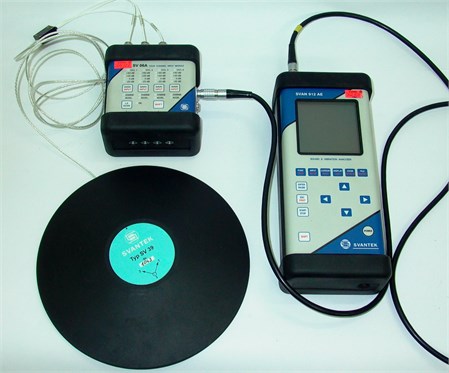
Each time the sound level meter was used, it was placed in a distance of ca. 5 m from the track axis, at the altitude of 1.6 m from the rail head. Vibrations were measured in a distance of 3.5 m from the track axis, directly on the road surface.
Because of the measurement location, namely a town centre, in order to maintain actual operating conditions of tram cars, a decision was made to measure the running speed in sections, thus obtaining an estimation of the dynamics of running in the measurement section. Furthermore, in order to minimise the impact of other sources of vibrations and noise in the transport microsystem examined, traffic was stopped in the section of the street where the measurement was to be taken. Consequently, the only source of disturbances in the transport system studied was actually the tram subject to tests.
Overview of the measurement site while the studies were being conducted have been depicted in Fig. 3.
Fig. 3Performing studies of vibrations and noise generated by a running tram
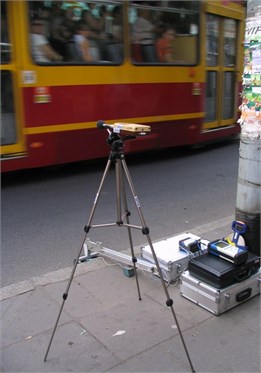
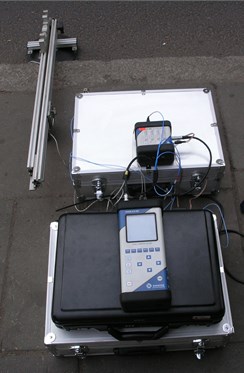
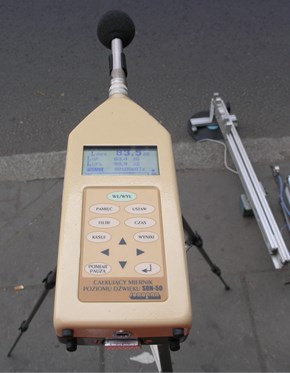
The tram cars examined were of the same type. One of the most popular tram cars was chosen for tests, namely the 805 N type which – despite its design being obsolete – is still often operated in municipal rolling stocks after retrofitting.
Fig. 4Tram vehicle 805N

3. Research results
The measurement results were collated according to the increasing tram running speed. In order to illustrate and analyse the results, Leq was collated after being corrected with curve A which corresponds to the hearing capacity characteristics of a human ear. For the energy equivalent of vibration accelerations, a root mean square (RMS) value was assumed, calculated each time for the signal of vibration accelerations recorded while the tram car was running.
The results obtained have been provided in the Figs. 5 and 6.
Fig. 5The distribution of RMS values of vibration acceleration for different tram speed
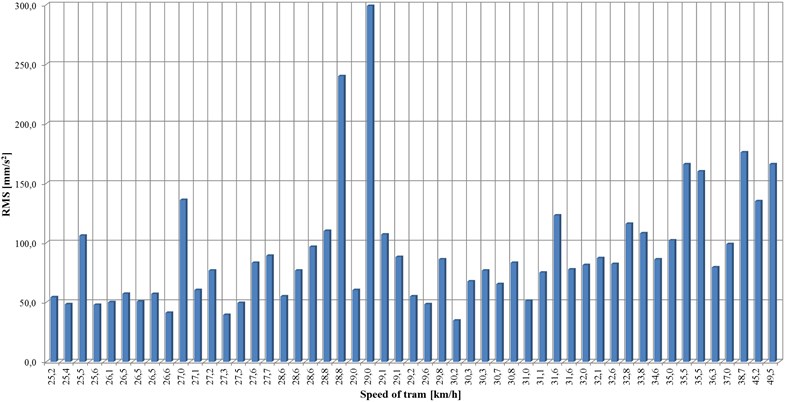
Fig. 6The distribution of sound level (Leq dB(A)) values for different tram speed
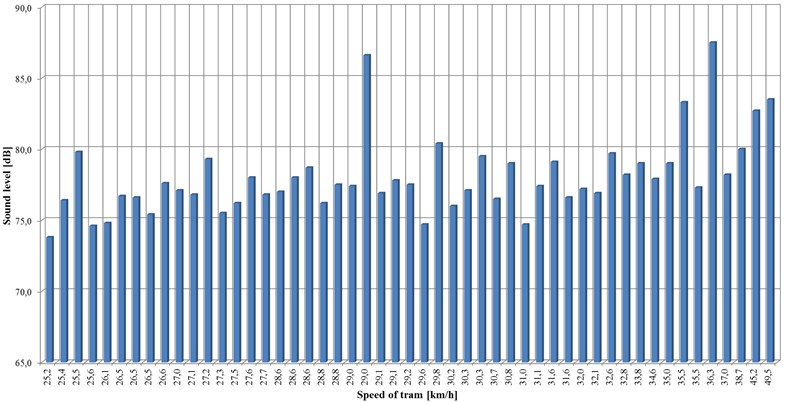
4. Conclusions
This paper is an extended abstract which constitutes only a fragment of a larger publication addressing extensive studies of vibrations and noise generated by rail vehicles operated in passenger transport. The results obtained in the course of the studies enable assessment and analysis of vibroacoustic phenomena induced by rail vehicles in operation. The impact of tram cars is particularly important in the urban environment. A preliminary analysis of the results obtained implies considerable spread of sound level values as well as root mean square values of vibrations. It is also impossible to unambiguously determine a trend for the phenomena in question in the function of growing dynamics of impacts triggered by changes in the running speed.
For the sake of precise analysis, the scope of studies and analyses should be extended by verification of technical condition of the vehicle subunits which may affect the level of dynamic impacts generated.
However, it would be reasonable to orient further studies on determination of reasons for the occurrence of local maxima of accelerations and noise on the speed of ca. 29 km/h for the 805 N tram subject to examination It is also necessary to conduct a modal or operational analysis which may indicate free vibration frequencies of the system studied and make it possible to explicitly determine whether or not these frequencies correspond to the frequencies of the vehicle input functions caused by defects on the wheel tread, rails and devices installed inside the vehicle, which would consequently allow for supressing phenomena being the most deleterious ones under urban conditions.
References
-
Cheli F., Corradi R. On rail vehicle vibrations induced by track unevenness: Analysis of the excitation mechanism. Journal of Sound and Vibration, Vol. 330, 2011, p. 3744-3765.
-
Burdzik R. Monitoring system of vibration propagation in vehicles and method of analysing vibration modes. Springer, Heidelberg, 2012, p. 406-413.
-
Burdzik R. Research on structure and directional distribution of vibration generated by engine in the location where vibrations penetrate the human organism. Diagnostyka, Vol. 14, Issue 2, 2013, p. 57-61.
-
Figlus T., Wilk A., Madej H., Łazarz B. Investigation of gearbox vibroactivity with the use of vibration and acoustic pressure start-up characteristics. Archive of Mechanical Engineering, Vol. 58, Issue 2, 2011, p. 209-221.
-
Burdzik R., Folęga P., Łazarz B., Stanik Z., Warczek J. Analysis of the impact of surface layer parameters on wear intensity of frictional couples. Archives of Materials and Metallurgy, Vol. 57, Issue 4, 2012, p. 987-993.
-
Blacha L., Siwiec G., Oleksiak B. Loss of aluminium during the process of Ti-Al-V alloy smelting in a vacuum induction melting (VIM) furnace. Metalurgija, Vol. 52, Issue 3, 2013, p. 301-304.
-
Węgrzyn T., Piwnik J., Burdzik R., Wojnar G., Hadryś A. New welding technologies for car body frame welding. Archives of Materials Science and Engineering, Vol. 58, Issue 2, 2012, p. 245-249.
-
Węgrzyn T., Piwnik J., Łazarz B., Hadryś D. Main micro-jet cooling gases for steel welding. Archives of Materials and Metallurgy, Vol. 58, Issue 2, 2013, p. 551-553.
-
Folęga P., Siwiec G. Numerical analysis of selected materials for flexsplines. Archives of Metallurgy and Materials, Vol. 57, Issue 1, 2012, p. 185-191.
-
Folęga P. The study of the dynamic properties of some structural components of harmonic drive. Journal of Vibroengineering, Vol. 15, Issue 4, 2013, p. 2096-2102.
-
Wyllie I. H., Griffin M. J. Discomfort from sinusoidal oscillation in the pitch and fore-and-aft axes at frequencies between 0.2 and 1.6 Hz. Journal of Sound and Vibration, Vol. 324, 2009.
-
Doleček R., Novák J., Černý O. Experimental research of harmonic spectrum of currents at traction drive with PMSM. Radioengineering, Vol. 20, Issue 2, 2011, p. 512-515.
-
Nejlaoui M., Affi Z., Houidi A., Romdhane L. Analytical modeling of rail vehicle safety and comfort in short radius curved tracks. Comptes Rendus Mecanique, Vol. 337, 2009, p. 303-311.
-
Manka A., Mgłosiek G. The use of computer methods CAX and FEM modeling of railway vehicles. Overview Communication, Vol. 62, Issue 7, 2007, p. 13-20.
-
Sayyaadi H., Shokouhi N. A new model in rail–vehicles dynamics considering nonlinear suspension components behavior. International Journal of Mechanical Sciences, Vol. 51, Issue 3, 2009, p. 222-232.
